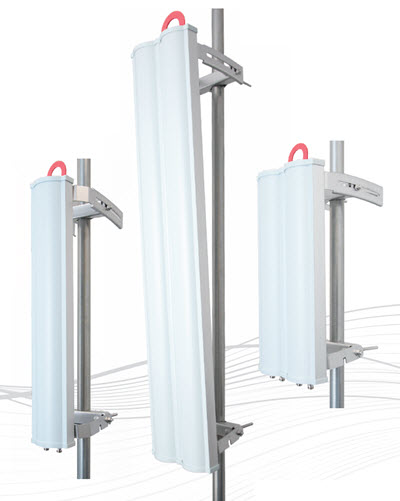3 Key Factors to Consider When Evaluating Sector Antenna Performance

Not all sector antennas offer the same level of quality and performance so it’s critical to conduct thorough research to make sure the model you choose will meet your exact expectations and deliver a strong ROI.
There are several factors to consider when purchasing a sector antenna, some of the most important being:
Gain Consistency:
Before buying an antenna, check whether gain is distributed evenly across the antenna’s entire frequency range. Many sector antennas have inconsistent coverage across different channels, resulting in spotty coverage which leads to increased customer calls/complaints and costly service calls.
Front-to-Back Ratio:
This is a measurement of the antenna’s gain in both the front and rear. You’ll want to choose an antenna with a front-to-back ratio between 30 and 35 dBi, along with a wide angle to prevent unwanted interference from leaking out and impacting the network.
Nulls:
Uniform coverage is not always guaranteed with sector antennas. Oftentimes, sector antennas will generate weak signals at various intervals from the base station. These weak spots are called “nulls” and tend to occur closer to the antenna. It’s important to select an antenna with the first null filled above 20 dB for optimal performance.
Recent advancements in the sector antenna market help overcome these challenges, allowing internet service providers to get more out of their equipment. KP Performance, for instance, now offers their brand-new ProLine Sector Antennas which provide a major leap over competing models in terms of performance, efficiency and ROI.
ProLine antennas are specifically engineered to deliver stable performance over wide bandwidths with flat gain, for reduced distortion. Single and dual-band options are available for 2x2, 4x4 and 8x8 MIMO in the following frequencies:
- 2.3-2.7 GHz
- 3.5-4.2 GHz
- 4.9-6.4 GHz
By including multiple frequencies and ports in a single radome, it’s possible to integrate multiple radio platforms onto a single antenna mounting point, reducing wind load and saving money on tower rental costs.
The ProLine series also features superior port isolation of < 20 dB, which is necessary to prevent unwanted energy transfers between ports. This is a fundamental element of MIMO, as each chain must be uncorrelated, or independent from one another. KP’s ProLine antennas also have an industry-leading cross polarization discrimination of < 10 dB, to prevent further unwanted energy transfers from occurring.
What’s more, these ProLine antennas feature upper side lobe suppression (USEL), for reduced inter-cell interference. With micropops, a strategy called downtilt, is necessary to reduce interference with adjacent cell towers; ProLine antennas are specially designed to reduce upper elevation side lobes, which tend to point toward the horizon and create interference.
Further attention is given to the area directly below the main beam, where there is often a sharp pattern drop, causing nulls close to the tower. ProLine antennas redistribute power below the main beam, boosting coverage for subscribers that live in close proximity to the base station.
The ProLine series features multiple beamwidth options for frequency re-use, as well as an integrated hoisting hook for safe and convenient installations; heavy-duty aluminum brackets protected with powder coated steel hardware; a universal radio bracket with a quick-release slot/clip design (compatible with many AP radios); and mount to any size mast from 0.75 to 4.5 inches.
To learn more about KP’s ProLine antennas, click here.